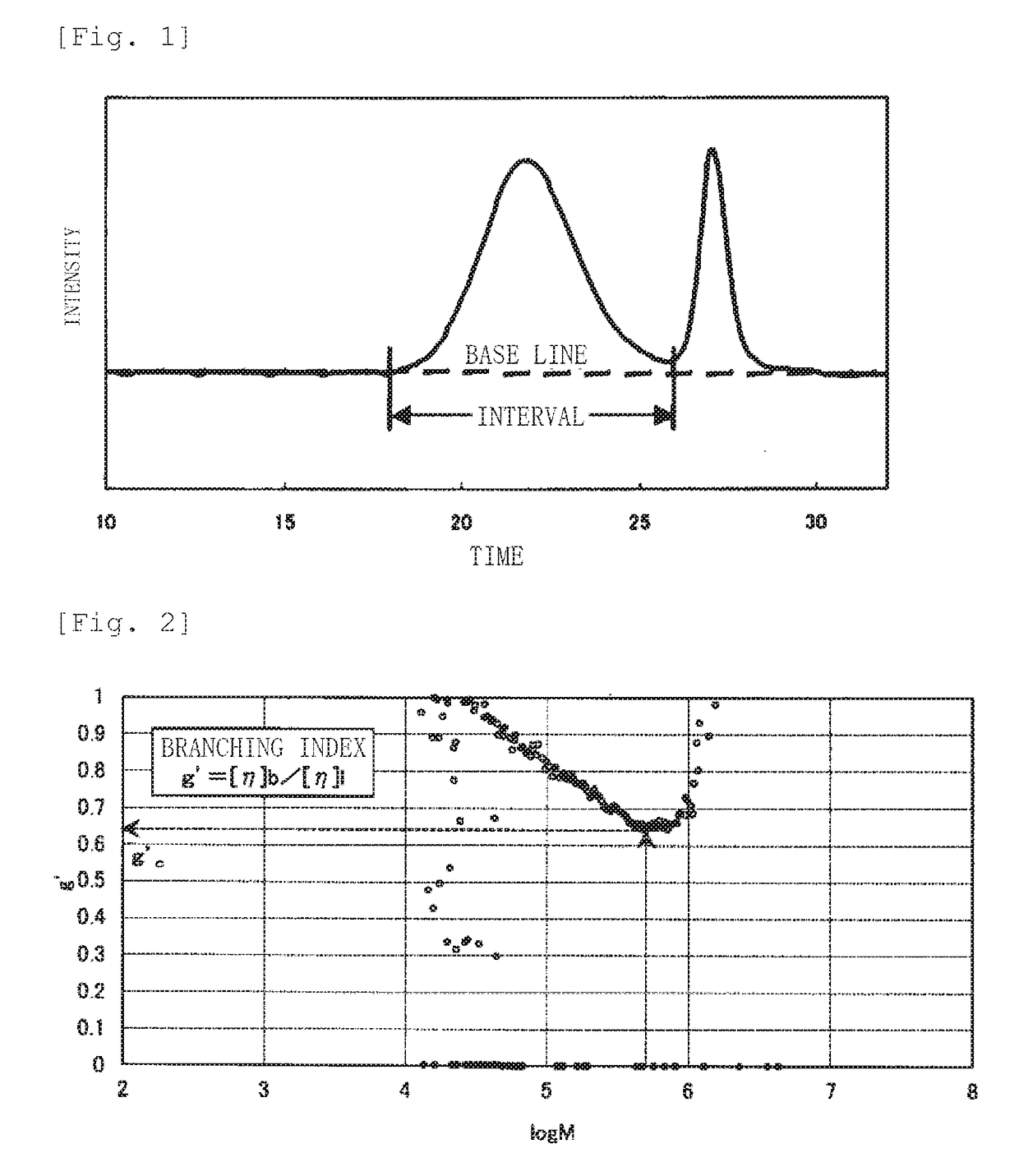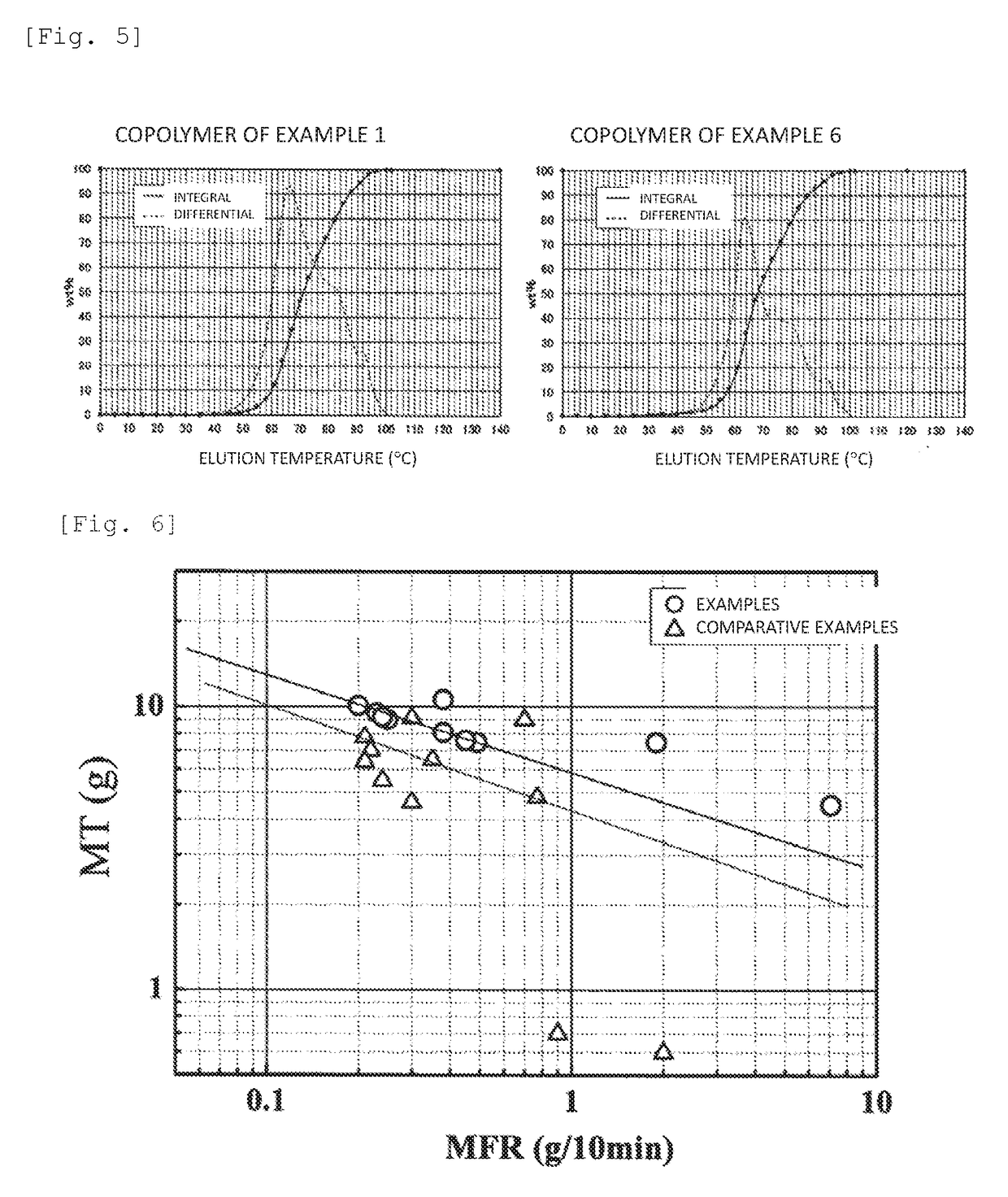ETHYLENE-a-OLEFIN COPOLYMER AND OLEFIN RESIN COMPOSITION
a technology of olefin resin and ethylene, which is applied in the field of new ethyleneolefin copolymer and novel olefin resin composition, can solve the problems of insufficient fluidity, difficulty in maintaining sufficient moldability, and insufficient melt properties of ethylene homopolymers, and achieves good molding properties, high melting tension, and high mechanical strength.
- Summary
- Abstract
- Description
- Claims
- Application Information
AI Technical Summary
Benefits of technology
Problems solved by technology
Method used
Image
Examples
example 1
[0317](1) Synthesis of Bridged Cyclopentadienyl Indenyl Compound
[0318]Dimethylsilylene(4-(4-trimethylsilyl-phenyl)-indenyl) (cyclopentadienyl) zirconium dichloride was synthesized according to the method described in paragraphs [0140] to [0143] of JP 2013-227271 A.
(i) Metallocene compound A: Synthesis of dimethylsilylene(4-(4-trimethylsilyl-phenyl)-indenyl) (cyclopentadienyl)zirconium dichloride
(1-1) Synthesis of 4-(4-trimethylsilyl-phenyl)-indene
[0319]To a 500-ml flask were added 10.0 g (51.5 mmol) of 4-trimethylsilylphenylboronic acid and 200 ml of dimethoxyethane to form a solution. Subsequently, 27.3 g (128 mmol) of potassium, phosphate, 100 ml of water, 8.37 g (43.0 mmol) of 4-bromoindene, 0.22 g (0.86 mmol) of triphenylphosphine, and 0.300 g (0.430 mmol) of PdCl2(PPh3)2 were sequentially added to the flask and stirred under reflux for 12 hours. After cooling to room temperature, 100 ml of water was added to the flask. After the organic phase was separated, the aqueous phase wa...
example 2
[0328]Production of Ethylene-1-Hexene Copolymer
[0329]Continuous gas-phase copolymerization of ethylene with 1-hexene was performed in the same manner as in Example 1 (3), except, that the copolymerization was performed under the conditions shown in Table 2 using the powdery catalyst obtained. Example 1 (2). The results are shown in Table 3.
example 3
[0330]Production of Ethylene-1-Hexene Copolymer
[0331]Continuous gas-phase copolymerization of ethylene with 1-hexene was performed in the same manner as in Example 1 (3), except that the copolymerization was performed under the conditions shown in Table 2 using the powdery catalyst obtained Example 1 (2). The results are shown in Table 3.
PUM
| Property | Measurement | Unit |
|---|---|---|
| density | aaaaa | aaaaa |
| cross fractionation chromatography | aaaaa | aaaaa |
| molecular weights | aaaaa | aaaaa |
Abstract
Description
Claims
Application Information
 Login to View More
Login to View More - R&D
- Intellectual Property
- Life Sciences
- Materials
- Tech Scout
- Unparalleled Data Quality
- Higher Quality Content
- 60% Fewer Hallucinations
Browse by: Latest US Patents, China's latest patents, Technical Efficacy Thesaurus, Application Domain, Technology Topic, Popular Technical Reports.
© 2025 PatSnap. All rights reserved.Legal|Privacy policy|Modern Slavery Act Transparency Statement|Sitemap|About US| Contact US: help@patsnap.com



